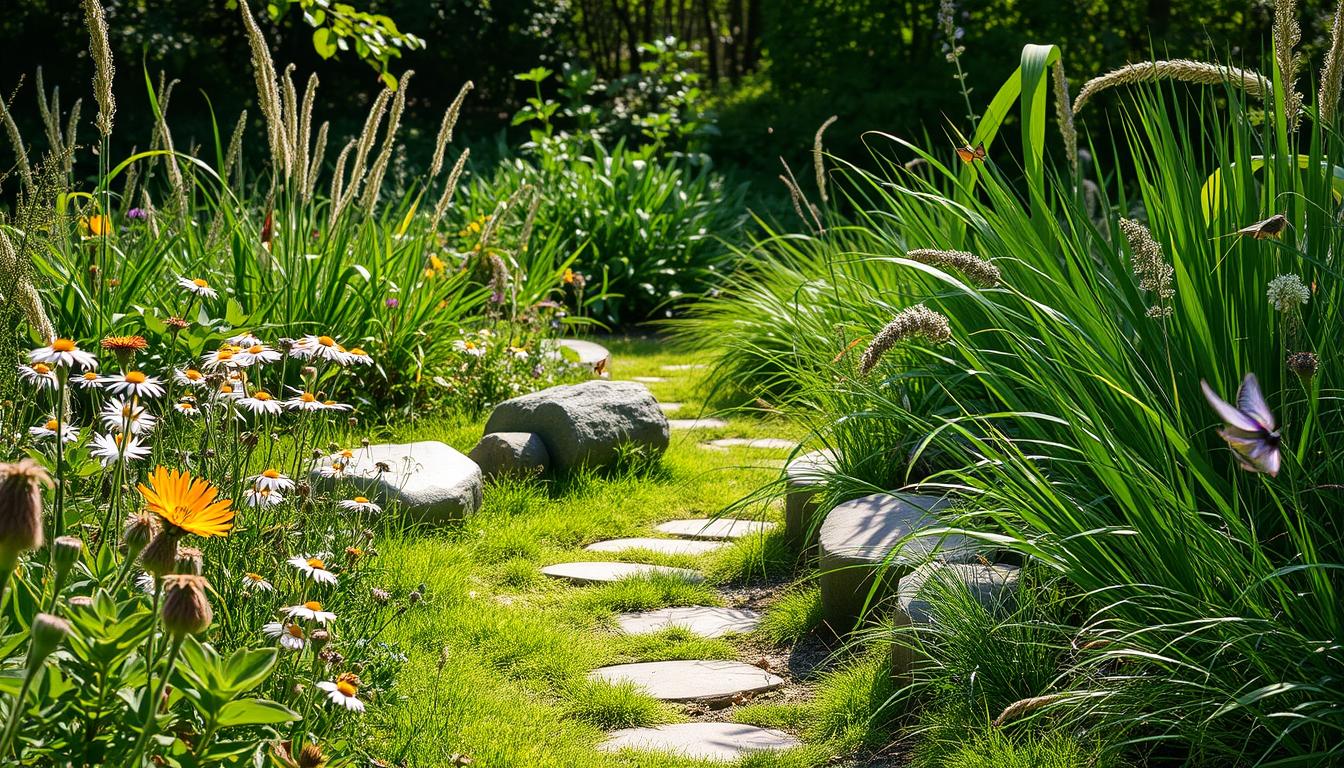Welcome to our comprehensive guide on natural borders. Here, we’ll dive into the advantages of using natural elements in your garden and outdoor spaces. This guide is perfect for both experienced gardeners and novices, aiming to turn your yard into a stunning and practical area.
Natural borders are essential in outdoor design, boosting both the look and use of your garden. By adding plants, stones, and wood, you can craft a welcoming space that matches your landscape perfectly.
We aim to equip you with the tools and knowledge for creating breathtaking natural garden borders. These borders not only beautify your outdoor area but also support sustainability and environmental care. We’ll cover everything from planning and design to upkeep, focusing on natural, garden, and landscape borders.
Key Takeaways
- Natural borders can enhance the aesthetic and functionality of your garden borders
- Incorporating natural elements, such as plants and stones, can promote sustainability
- Proper planning and design are crucial for creating effective natural garden borders
- Landscape borders can be designed to complement your natural borders
- Regular maintenance is necessary to ensure the longevity of your natural garden borders
- Natural borders can increase the value and appeal of your outdoor space
Understanding Natural Garden Borders
Natural garden borders are vital in defining your yard’s different areas. They create a sense of separation and provide habitat for local wildlife. When designing your garden, it’s crucial to consider the natural boundaries and garden edges. These elements enhance your outdoor space’s aesthetic and functionality.
The benefits of natural boundaries are numerous. Various border design options can achieve these benefits. Popular designs include stone walls, living fences, and wooden borders. These designs beautify your garden and separate different yard areas.
Benefits of Natural Boundaries
Natural boundaries offer several benefits, including reduced maintenance and increased biodiversity. Incorporating natural elements into your garden design creates a unique ecosystem. This ecosystem attracts local wildlife and enhances your outdoor space’s beauty.
Different Types of Natural Borders
There are several types of natural borders to choose from, including:
- Stone walls: a classic and durable option
- Living fences: a great way to attract local wildlife
- Wooden borders: a versatile and low-maintenance option
Environmental Impact Considerations
When designing your natural garden borders, consider their environmental impact. Choose sustainable, locally sourced materials. Also, think about the impact on local wildlife and ecosystems.
Understanding natural garden borders’ benefits and options helps create a beautiful, functional outdoor space. This space enhances your overall quality of life.
| Border Design | Benefits | Environmental Impact |
|---|---|---|
| Stone walls | Durable, low-maintenance | High carbon footprint |
| Living fences | Attracts local wildlife, increases biodiversity | Low carbon footprint |
| Wooden borders | Versatile, low-maintenance | Medium carbon footprint |
Planning Your Garden Border Design
In garden planning, designing your landscape borders is a critical step. It’s where creativity shines, transforming your outdoor space. Begin by evaluating your yard and identifying your needs. Consider the climate, soil type, and maintenance needs for your area. This will guide you in selecting the perfect natural borders for your garden.
A well-thought-out landscape borders design significantly impacts your outdoor space’s look and feel. Key factors to ponder include:
- Climate: Opt for plants that thrive in your local climate.
- Soil type: Choose plants that match your soil type, whether clay, sand, or loam.
- Maintenance: Select plants that align with your maintenance capabilities.
By investing time in garden planning and natural borders design, you craft a beautiful, functional outdoor area. Remember to tailor your choices to your specific needs. Choose plants that are compatible with your climate, soil, and maintenance level. With careful planning and creativity, you’ll create a breathtaking landscape borders that will impress your neighbors.
Essential Tools and Materials for Natural Borders
To craft a stunning and practical natural garden border, you need the correct tools and materials. When planning your border design, think about the garden edges you desire and the plant selection that will flourish in your area. Begin with basic garden tools like a shovel, rake, and pruning shears.
Choosing the right border materials is also key. Options include natural stone, wood, or plants that enhance your garden edges and border design. Assess the durability and upkeep needs of each material before deciding.
Basic Garden Equipment Needed
- Shovel for digging and planting
- Rake for smoothing out soil and debris
- Pruning shears for trimming and shaping plants
Selecting Border Materials
When picking border materials, align them with your garden’s style and theme. Natural stone and wood bring a rustic charm, while plants add color and texture. Remember to choose plants that thrive in your climate and complement your garden edges.
Safety Considerations
Always prioritize safety when using power tools and sharp objects. Wear gloves and safety glasses for protection. Keep children and pets away from your workspace.
| Tool | Safety Precaution |
|---|---|
| Pruning shears | Wear gloves to protect hands from cuts |
| Power tools | Wear safety glasses and keep loose clothing tied back |
Choosing the Right Plants for Border Gardens
When selecting plants for your border garden, several factors come into play. The right plants can elevate the beauty of your natural boundaries and transform your outdoor space. Begin by considering your local climate, soil type, and your maintenance commitment.
Effective garden planning means picking plants that match your specific conditions. Think about growth habits, bloom times, and foliage texture. This way, you can craft a stunning and practical border garden that complements your natural boundaries.
Here are some plant selection tips:
- Opt for native plants for a low-maintenance choice
- Ensure the plants’ mature size fits your border garden
- Choose a variety of plants with different bloom times for a vibrant display
By adhering to these guidelines and aligning with your garden planning objectives, you can develop a vibrant border garden. This garden will not only beautify your natural boundaries but also thrive.
Natural Border Installation Techniques
Creating a natural garden border demands meticulous planning and execution. Begin by clearing the ground of debris, weeds, and lawn. This step ensures a clean start, allowing for a smooth surface for your borders.
A well-designed garden edge significantly enhances your yard’s look. It’s vital to select the right materials and techniques for edge maintenance. Options like brick, stone, and wood offer various styles and designs for your garden edges.
Ground Preparation Steps
- Remove debris, weeds, and existing lawn
- Level the ground to create a smooth surface
- Test the soil to determine its pH level and nutrient content
Planting Methods
After preparing the ground, it’s time to plant. Select plants that match your climate and soil type. Arrange them to create a visually appealing landscape. Mix plants with different textures, colors, and growth habits to add depth and interest.
Border Edging Tips
Regular edge maintenance is crucial for keeping your garden edges looking great. Tasks like pruning, weeding, and mulching help keep the area tidy. By following these tips and using the right materials, you can create a beautiful, functional natural garden border.
Creating Living Fence Boundaries
Living fence boundaries are a fantastic way to demarcate your outdoor area. They offer a natural and aesthetically pleasing solution for garden planning. For those seeking natural boundaries, living fences stand out as a unique and practical choice. They effectively separate your garden from the surrounding environment.
Living fences also serve as a habitat for local wildlife, enhancing your garden’s biodiversity. To establish a living fence, selecting the appropriate plants is crucial. Consider climate, soil type, and desired height. Shrubs, trees, and flowering plants are popular choices for this purpose.
When designing your border design, align it with your garden’s style and theme. Also, factor in the maintenance level you’re prepared to undertake. A well-designed living fence can be a breathtaking feature of your outdoor space. It offers a natural and beautiful way to define your garden’s edges.
Here are some tips for creating a living fence boundary:
- Choose plants that are suitable for your climate and soil type
- Consider the mature size of the plants and leave enough space for growth
- Water and maintain your living fence regularly to ensure its health and longevity
Incorporating Hardscape Elements in Natural Borders
To enhance your landscape borders, consider adding hardscape elements. These features add texture, depth, and visual interest. They can define different areas, like seating or pathways, within your natural borders.
When designing your garden edges, think about how hardscape elements can complement your natural borders. For instance, stone or rock features create a durable, low-maintenance border. Wooden elements, like fences or trellises, add warmth and coziness.
Stone and Rock Features
Stone and rock features are a favorite for hardscape elements in natural borders. They can form various features, such as retaining walls, patios, and walkways. These elements help define your garden edges and separate different yard areas.
Wooden Border Elements
Wooden border elements, like fences and trellises, bring warmth and coziness to your outdoor space. They offer privacy and define your garden edges. Pairing wooden elements with plants and flowers creates a welcoming outdoor space.
Natural Material Combinations
Combining natural materials, such as stone and wood, creates unique and beautiful hardscape elements. These combinations add texture, depth, and visual interest. Use them to craft features like benches, planters, and water features.
| Hardscape Element | Material | Description |
|---|---|---|
| Retaining Wall | Stone | A wall used to retain soil and create a flat area |
| Patio | Stone or Rock | A flat area used for outdoor seating and entertainment |
| Walkway | Stone or Rock | A path used to connect different areas of the yard |
Seasonal Maintenance for Garden Borders
To maintain your garden border’s beauty, regular edge maintenance is key. Tasks like pruning, watering, and fertilizing are vital for plant health and appearance. Effective garden planning is also essential. It prepares your border for seasonal changes, ensuring your natural boundaries flourish.
In spring, focus on pruning and watering to encourage growth. As temperatures rise, introduce new plants and features like stones to boost beauty. Summer demands consistent upkeep to prevent overgrowth and keep border shapes intact.
Fall and winter require preparation for cold weather. Mulching and protecting plants from harsh conditions are crucial. These steps help preserve your natural boundaries, ensuring they thrive when warmer weather returns. Adhering to these seasonal maintenance tips will keep your garden border in prime condition, allowing you to enjoy its beauty year-round.
| Season | Maintenance Tasks |
|---|---|
| Spring | Pruning, watering, fertilizing |
| Summer | Regular upkeep, pruning, watering |
| Fall and Winter | Mulching, protecting plants from harsh weather |
Troubleshooting Common Border Issues
Even with careful planning and upkeep, garden edges can still face common problems. Identifying the cause and taking action is key. Issues like overgrowth, erosion, and pests can harm your border’s look and function.
To tackle overgrowth, prune or trim plants often. This keeps your garden edges looking neat. For erosion, consider a retaining wall or natural materials to strengthen your garden’s edges. To fight pests, introduce beneficial insects or opt for organic pest control.
Preventing these problems requires some effort. Here are helpful tips:
- Regularly check your garden edges and borders for damage or wear.
- Keep a balance of plants and natural materials in your borders.
- Choose plants with different growth habits for a diverse and strong border.
By following these tips and staying proactive, you can create a stunning natural border. It will enhance your outdoor space beautifully.
Conclusion: Embracing the Beauty of Natural Boundaries
In wrapping up our exploration of natural garden borders and boundaries, it’s evident that they bring both beauty and utility to outdoor areas. By choosing the right plants and materials, you can craft a border that beautifully complements your landscape. It also showcases your personal taste.
Success hinges on grasping your garden’s specific needs, from soil types to climate. With thoughtful planning and creativity, you can create a natural border. This not only beautifies your property but also supports environmental sustainability. Let the natural allure of these boundaries enrich your gardening experience.


